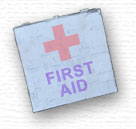|
 Alpacas are generally cooperative travelers, which often leads alpacas owners to believe moving alpacas is simple. Not so. Transporting
alpacas (especially for any distance) is an activity that shouldn't be undertaken lightly. Whether or not an alpaca shows signs of stress,
traveling is stressful for most alpacas. Here are eight tips essential to
the safe transport of alpacas. Alpacas are generally cooperative travelers, which often leads alpacas owners to believe moving alpacas is simple. Not so. Transporting
alpacas (especially for any distance) is an activity that shouldn't be undertaken lightly. Whether or not an alpaca shows signs of stress,
traveling is stressful for most alpacas. Here are eight tips essential to
the safe transport of alpacas. 1. Be prepared for temperature
extremes. Heat is usually more of a problem than cold. It is generally
better to ship in the spring and fall because temperatures are less extreme. Adjustable, adequate
ventilation or air-conditioning is essential. Without a well ventilated or air-
conditioned traveling space, summer temperatures can create dangerous situations. It is important to keep in mind many forms
of transportation are safe only while moving, when the air flow passing through a vehicle
protects alpacas against heat build-up or when air-conditioning can maintain a desired temperature throughout a
traveling space. As a general rule, both humidity and ambient temperature should be
monitored. Temperatures as low as 75 degrees F in humid conditions and 85 degrees F in dry conditions
may cause problems. Traveling at night is a common strategy used to avoid heat.  In cold weather, restricting airflow may be necessary to reduce the wind chill factor and allow a group of
animalsí body heat to help warm the traveling compartment. The floor may need extra insulation,
and alpacas must have ample water and food to process food efficiently enough to maintain body
temperature. Water intake is essential during excessive cold, which is sometimes overlooked. Cold below 32 degrees
F can be dangerous to suris and huacaya crias. Temperatures of below 10 degrees F
can be dangerous to adult huacayas. By monitoring weather forecasts, you may want to reschedule a trip
or reroute if particularly extreme temperatures are forecast. In cold weather, restricting airflow may be necessary to reduce the wind chill factor and allow a group of
animalsí body heat to help warm the traveling compartment. The floor may need extra insulation,
and alpacas must have ample water and food to process food efficiently enough to maintain body
temperature. Water intake is essential during excessive cold, which is sometimes overlooked. Cold below 32 degrees
F can be dangerous to suris and huacaya crias. Temperatures of below 10 degrees F
can be dangerous to adult huacayas. By monitoring weather forecasts, you may want to reschedule a trip
or reroute if particularly extreme temperatures are forecast.
2. Carry thermometers and humidity
gauge. A weather thermometer should be mounted in the
traveling compartment. When the temperature exceeds 80 degrees F, the animals should be
monitored for elevated respiration and signs of heat stress. If the combinations of temperature
and humidity exceed 150, alpacas should be monitored. A clinical thermometer is important. If an alpaca starts
to show open mouthed breathing or lethargy and has a rectal temperature of above 106 F,
efforts should be made to cool the alpaca by running water on the animals underside. 3. Carry extra
water. Carrying water in 5-10 gallon closed containers allows
you to respond immediately to filling onboard water containers when there is no
available running water. Just as importantly in heat stress related emergencies, having extra water on
board allows you to respond to an emergency. If you find yourself needing to cool an animal far
from a water source, donít pour the water over the alpacas. Instead, fill
a bucket (preferably a tall one) in a shady area and stand the animal in
the bucket until his respiration and alertness return to normal. By standing an alpaca in this manner, the water is not
wasted and can be used over a period of time. 4. Avoid incompatible mixes and
overcrowding. The longer the journey the greater per-animal space allotment. Overcrowding increases stress, may result in dominant
animals intimidating subordinate animals from eating and drinking, and increases the likelihood of fecal contamination
of food sources. It may be necessary to have multiple water and feed sources in a large shipping compartment.
Also, forcing animals with a history of disliking one another into a small compartment together increases stress.
If possible, assign animals to a compartment that are
known to be compatible. 5. Have an emergency plan. There should be enough halters and lead ropes available for each animal.
The halters should be prefitted and readily available for rapid unloading. It also makes good sense to
carry a picket line. By stringing the line along the ground and securing
it with two spikes or by tying it between two stationary objects, the alpacas lead ropes can be secured,
allowing you to cope with whatever
problems have forced you to evacuate the vehicle.  It makes good sense to have a national camelid directory (preferably both ILA and AOBAís directories) on board,
so you can call a llama or alpaca owner if your vehicle should become inoperable. It also pays to have an onboard
first aid kit that includes saline solutions, wound cleanser, electrolytes and injectable antibiotics. If the situation appears
life threatening, consult one of the national directories to locate a qualified veterinarian nearest to your location. It makes good sense to have a national camelid directory (preferably both ILA and AOBAís directories) on board,
so you can call a llama or alpaca owner if your vehicle should become inoperable. It also pays to have an onboard
first aid kit that includes saline solutions, wound cleanser, electrolytes and injectable antibiotics. If the situation appears
life threatening, consult one of the national directories to locate a qualified veterinarian nearest to your location.
6. Know how to safely load and unload
alpacas. This may seem readily apparent, but because each vehicle
has different strengths and weaknesses as far as hauling alpacas is concerned it may
be worthwhile to consider the peculiarities of your vehicle with an eye for ease in loading and unloading animals. Is the
height or the vehicle too high? Are there hazards such as gaps between the tailgate (or door)
and bumper that must be covered to avoid a serious leg injury? Is the flooring covered with rubber or suitable
skid-proof surface? If an alpaca is untrained or simply refuses to climb into a vehicle, it may be necessary to employ the
ďalpaca liftĒ. This requires two people on each side of the alpaca. By reaching under the
animalís abdomen and grasping hands around the animalís chest, an alpaca can be lifted
off the ground and placed into a vehicle. Most animals will accept being lifted for a few seconds
in this manner without struggling which is usually ample time to load an animal. Unloading may seem simple enough not to merit a comment. However, injuries have been reported.
First all gaps between tailgates (or doors) and bumpers must be covered and each animal directed to the ground
in a controlled manner. Donít assume a kushed alpaca will automatically drop itís legs to break itís fall if it is pulled from a
conveyance immediately after opening a door. For many alpacas the realization that the trip is over and it is time to disembark may take a
few minutes to sink in. Alpacas often need a moment or two to collect themselves before standing or stepping down to the ground. 7. Avoid jeopardizing a
pregnancy. Pregnant alpacas are shipped regularly, but there are additional risks with pregnant animals, especially
those in their third trimester. Females shipped in the ending months of their pregnancy have been
known to abort during transport or within a week of arriving at a new destination. Many unrelated factors can cause abortions, but the fact
that an
inordinate number have occurred during and after traveling indicates late-term alpacas sometimes have difficulty coping
with the stress transportation creates during late-term pregnancies. If a female slated
for transportation is near term, it is better to wait until the cria is a
month old before shipping. 8. Minimize feed and water contamination and have a waste disposal
plan. Obviously avoiding contamination of feed and water is a goal of any transporter, but there are some
fairly subtle methods to consider.
Watering animals in a vehicle requires discretion and finesse. If the journey begins on curvy roads, no
water should be offered until a
smooth, even road surface is reached. Spilling water in the traveling conveyance will stimulate animals into
voiding their bowels. For some
reason standing water creates this reaction. To minimize water being spilled throughout a
traveling compartment, ďdouble bucketingĒ should be employed when possible. This technique requires
placing a small bucket in a wider based larger bucket. Only the small bucket is
partially filled with water. Any water that slops from the smaller bucket is caught in the larger bucket. Feed should be placed above the door or along the sides out of the main standing area to minimize fecal and
urine contamination. Lastly, if
trained animals are being transported, stopping to let them relieve themselves is a good idea. With untrained
alpacas, unloading during rest stops isnít usually wise or possible. Fecal pellets should be placed
in the area of the traveling conveyance to encourage bowel movements in places away from feed and water.
Often carpet or bedding where
this occurs is discarded a couple of times a day throughout a long trip.

|
